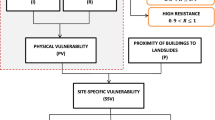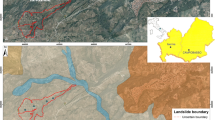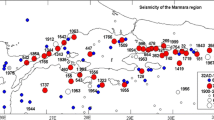Abstract
The process of land subsidence deals with the removal of excess pore water pressure and the compaction of soil mass under the effect of natural or human factors. The detrimental effects of land subsidence include changes in the morphology of the land surface and the formation of earth fissures, as well as structural and non-structural damage to surface and subsurface infrastructures. In Joshimath on 2nd January 2023, an incidence of ground subsidence occurred which damaged many buildings and infrastructures. This study addresses the exploratory work on rapid visual damage assessment of buildings based on method developed by National Disaster Management Authority (NDMA) and European Macroseismic Scale (EMS) − 98. The building vulnerability was assessed using building attributes like typology, number of storeys, area, construction materials, occupancy, configuration, construction practice etc. The damage attributes considered are based on siting issues, soil and foundation conditions, architectural features and elements, structural aspects and components, material & construction details, crack monitoring etc. In the critical buildings, cracks were monitored using crack meters. This study concludes out of total 2364 building surveyed, 37%, 42%, 20%, 1% buildings fall under “Usable”, “Further Assessment”, “Unusable”, “to be demolished”, grades respectively.














Similar content being viewed by others
References
Agarwal S, Kumar V, Kumar S, Sundriyal Y, Bagri DS, Chauhan N, Rana N (2022) Identifying potential hotspots of land use/land cover change in the last 3 decades, Uttarakhand, NW Himalaya.
Arlekar JN, Jain SK, Murty CVR, Rajendran CP, Rajendra K, Sinha R Chamoli (Himalaya, India) earthquake of 29 March 1999, EERI Special Earthquake Report, EERI Newsletter, 33, 7, July 1999.
Bera B, Saha S, Bhattacharjee S (2023) Sinking and sleeping of himalayan city Joshimath. Quaternary Sci Adv 12:100100
Bisht MPS, Rautela P (2010) Disaster looms large over Joshimath. Curr Sci (Bangalore) 98(10):1271
Census P Joshimath Town Population 2011–2023
FEMA 154 (2002) Rapid Visual Screening of Buildings for potential seismic hazards. Federal Emergency Management Agency, Washington DC
FEMA 178 (v), NEHRP handbook for the seismic evaluation of existing buildings, Federal Emergency Management Agency, Washington DC
FEMA 310 (1998) Handbook for the seismic evaluation of buildings. Federal Emergency Management Agency, Washington DC
FEMA P154 (2015) Rapid Visual Screening of Buildings for potential seismic hazards: a handbook. Federal Emergency Management Agency, Washington DC
Grunthal G (ed) (1998) European macroseismic scale 1998 (EMS-98); European Seismological Commission(ESC). Luxemburg
Heim A, Gansser A (1939) Central Himalaya: geological observations of Swiss expedition 1936, vol 246. Reprinted Hind. Publ. Co, Delhi
IS: 13935 (2009) Seismic Evaluation, Repair and Strengthening of Masonry Buildings-Guidelines, Bureau of Indian Standards, New Delhi, India 2009
Jain, A. K., Shreshtha, M., Seth, P., Kanyal, L., Carosi, R., Montomoli, C., … Rai,S. M. (2014). The Higher Himalayan Crystallines, Alaknanda–Dhauli Ganga Valleys, Garhwal Himalaya, India. Eds.) Chiara Montomoli, Rodolfo Carosi, Rick Law, Sandeep Singh,and Santa Man Rai, Geological field trips in the Himalaya, Karakoram and Tibet, Journal of the Virtual Explorer, Electronic Edition, ISSN, 1441–8142
JBDPA (2001) Standard for seismic capacity evaluation of existing Reinforced concrete buildings. Japan Build Disaster Prevention Association, Tokyo
Mishra Commission (1964) Report of the Commission set up by the government of India vide letter 142/23 – 5/44/76 dated 08.04.1976.
NDMA (2018) Earthquake Disaster Risk Index Report,50 towns & 1 District in Seismic zones III. IV and V, National Disaster Management Authority, Delhi
NDMA (2020) A primer on Rapid Visual Screening (RVS), consolidating Earthquake Safety Assessment efforts in India. National Disaster Management Authority, Delhi
NZSEE (2006) Assessment and Improvement of the Structural performance of buildings in earthquakes. New Zealand Society for Earthquake Engineering, Wellington, NZ
Office of the Registrar General and Census Commissioner Ministry of Home Affairs, Government of India, Census of India 2011.
Office of the Registrar General and Census Commissioner Ministry of Home Affairs, Government of India, Census of India 2001.
Sarkar S, Pandit K, Sharma M, Pippal A (2018) Risk assessment and stability analysis of a recent landslide at Vishnuprayag on the Rishikesh–Badrinath highway, Uttarakhand, India. Curr Sci, 1527–1533
Sati SP, Asim M, Sundriyal YP, Rana N, Bahuguna V, Sharma S (2023) Unstable slopes and threatened livelihoods of the historical Joshimath town, Uttarakhand Himalaya, India. Curr Sci (00113891), 124(12)
Singh S (2018) Alakhnanda–Bhagirathi River System. The Indian Rivers: Scientific and Socio-economic Aspects, 105–114
Acknowledgements
The authors thank the National Disaster Management Authority, Delhi, Government of Uttarakhand for motivation and support for this research work.
Funding
National Disaster Management Authority, Delhi and Government of Uttarakhand.
Author information
Authors and Affiliations
Corresponding author
Ethics declarations
Conflict of interest
The authors declare that they have no known competing financial interests or personal relationships that could have appeared to influence the work reported in this paper.
Additional information
Publisher’s Note
Springer Nature remains neutral with regard to jurisdictional claims in published maps and institutional affiliations.
Rights and permissions
Springer Nature or its licensor (e.g. a society or other partner) holds exclusive rights to this article under a publishing agreement with the author(s) or other rightsholder(s); author self-archiving of the accepted manuscript version of this article is solely governed by the terms of such publishing agreement and applicable law.
About this article
Cite this article
Chourasia, A., Dalbehera, M.M., Kapoor, A. et al. Damage assessment of buildings due to land subsidence in Joshimath town of Northwestern Himalaya, India. Nat Hazards (2024). https://doi.org/10.1007/s11069-024-06625-x
Received:
Accepted:
Published:
DOI: https://doi.org/10.1007/s11069-024-06625-x




